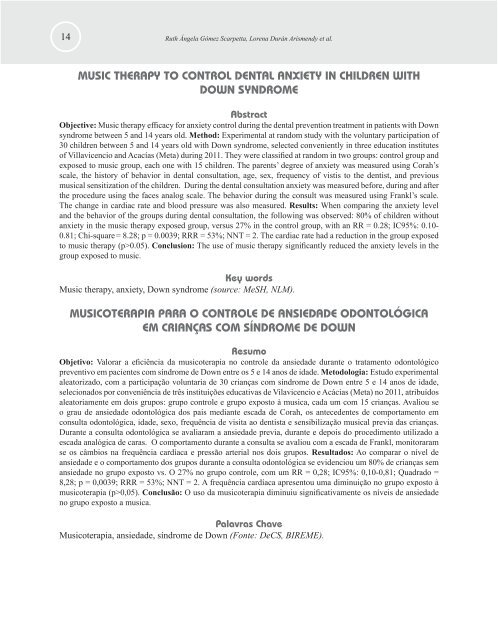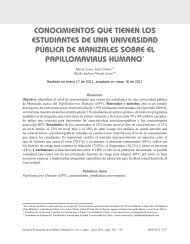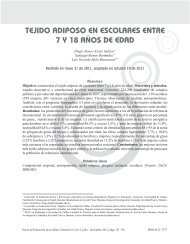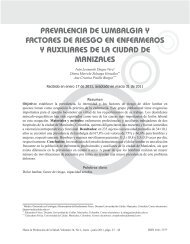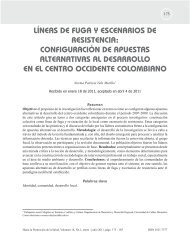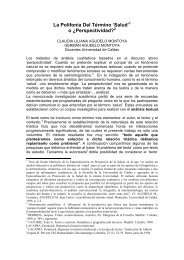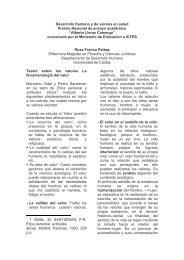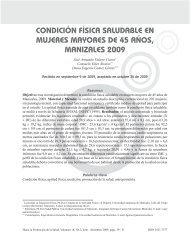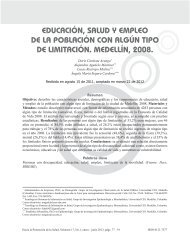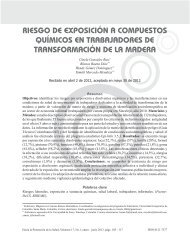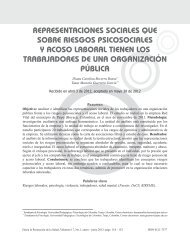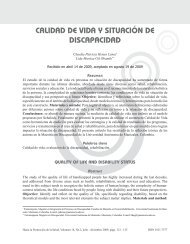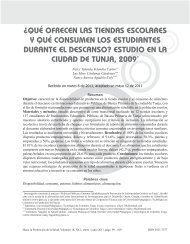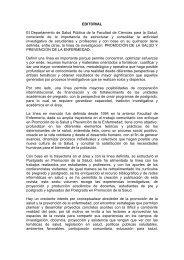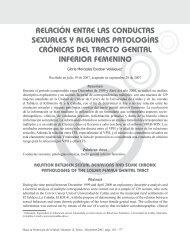14 Ruth Áng<strong>el</strong>a Gómez Scarpetta, Lor<strong>en</strong>a Durán Arism<strong>en</strong>dy et al.MUSIC THERAPY TO CONTROL DENTAL ANXIETY IN CHILDREN WITHDOWN SYNDROMEAbstractObjective: Music therapy efficacy for anxiety <strong>control</strong> during the <strong>de</strong>ntal prev<strong>en</strong>tion treatm<strong>en</strong>t in pati<strong>en</strong>ts with Downsyndrome betwe<strong>en</strong> 5 and 14 years old. Method: Experim<strong>en</strong>tal at random study with the voluntary participation of30 childr<strong>en</strong> betwe<strong>en</strong> 5 and 14 years old with Down syndrome, s<strong>el</strong>ected conv<strong>en</strong>i<strong>en</strong>tly in three education institutesof Villavic<strong>en</strong>cio and Acacías (Meta) during 2011. They were classified at random in two groups: <strong>control</strong> group an<strong>de</strong>xposed to music group, each one with 15 childr<strong>en</strong>. The par<strong>en</strong>ts’ <strong>de</strong>gree of anxiety was measured using Corah’sscale, the history of behavior in <strong>de</strong>ntal consultation, age, sex, frequ<strong>en</strong>cy of vistis to the <strong>de</strong>ntist, and previousmusical s<strong>en</strong>sitization of the childr<strong>en</strong>. During the <strong>de</strong>ntal consultation anxiety was measured before, during and afterthe procedure using the faces analog scale. The behavior during the consult was measured using Frankl’s scale.The change in cardiac rate and blood pressure was also measured. Results: Wh<strong>en</strong> comparing the anxiety lev<strong>el</strong>and the behavior of the groups during <strong>de</strong>ntal consultation, the following was observed: 80% of childr<strong>en</strong> withoutanxiety in the music therapy exposed group, versus 27% in the <strong>control</strong> group, with an RR = 0.28; IC95%: 0.10-0.81; Chi-square = 8.28; p = 0.0039; RRR = 53%; NNT = 2. The cardiac rate had a reduction in the group exposedto music therapy (p>0.05). Conclusion: The use of music therapy significantly reduced the anxiety lev<strong>el</strong>s in thegroup exposed to music.Key wordsMusic therapy, anxiety, Down syndrome (source: MeSH, NLM).MUSICOTERAPIA PARA O CONTROLE DE ANSIEDADE ODONTOLÓGICAEM CRIANÇAS COM SÍNDROME DE DOWNResumoObjetivo: Valorar a eficiência da <strong>musicoterapia</strong> no <strong>control</strong>e da ansieda<strong>de</strong> durante o tratam<strong>en</strong>to odontológicoprev<strong>en</strong>tivo em paci<strong>en</strong>tes com síndrome <strong>de</strong> Down <strong>en</strong>tre os 5 e 14 anos <strong>de</strong> ida<strong>de</strong>. Metodologia: Estudo experim<strong>en</strong>talaleatorizado, com a participação voluntaria <strong>de</strong> 30 crianças com síndrome <strong>de</strong> Down <strong>en</strong>tre 5 e 14 anos <strong>de</strong> ida<strong>de</strong>,s<strong>el</strong>ecionados por conv<strong>en</strong>iência <strong>de</strong> três instituições educativas <strong>de</strong> Vilavic<strong>en</strong>cio e Acácias (Meta) no 2011, atribuídosaleatoriam<strong>en</strong>te em dois grupos: grupo <strong>control</strong>e e grupo exposto à musica, cada um com 15 crianças. Avaliou seo grau <strong>de</strong> ansieda<strong>de</strong> <strong>odontológica</strong> dos pais mediante escada <strong>de</strong> Corah, os antece<strong>de</strong>ntes <strong>de</strong> comportam<strong>en</strong>to emconsulta <strong>odontológica</strong>, ida<strong>de</strong>, sexo, frequência <strong>de</strong> visita ao <strong>de</strong>ntista e s<strong>en</strong>sibilização musical previa das crianças.Durante a consulta <strong>odontológica</strong> se avaliaram a ansieda<strong>de</strong> previa, durante e <strong>de</strong>pois do procedim<strong>en</strong>to utilizado aescada analógica <strong>de</strong> caras. O comportam<strong>en</strong>to durante a consulta se avaliou com a escada <strong>de</strong> Frankl, monitoraramse os câmbios na frequência cardíaca e pressão arterial nos dois grupos. Resultados: Ao com<strong>para</strong>r o nív<strong>el</strong> <strong>de</strong>ansieda<strong>de</strong> e o comportam<strong>en</strong>to dos grupos durante a consulta <strong>odontológica</strong> se evi<strong>de</strong>nciou um 80% <strong>de</strong> crianças semansieda<strong>de</strong> no grupo exposto vs. O 27% no grupo <strong>control</strong>e, com um RR = 0,28; IC95%: 0,10-0,81; Quadrado =8,28; p = 0,0039; RRR = 53%; NNT = 2. A frequência cardíaca apres<strong>en</strong>tou uma diminuição no grupo exposto à<strong>musicoterapia</strong> (p>0,05). Conclusão: O uso da <strong>musicoterapia</strong> diminuiu significativam<strong>en</strong>te os níveis <strong>de</strong> ansieda<strong>de</strong>no grupo exposto a musica.Palavras ChaveMusicoterapia, ansieda<strong>de</strong>, síndrome <strong>de</strong> Down (Fonte: DeCS, BIREME).
Musicoterapia <strong>para</strong> <strong>el</strong> <strong>control</strong> <strong>de</strong> <strong>ansiedad</strong> <strong>odontológica</strong> <strong>en</strong> <strong>niños</strong> con síndrome <strong>de</strong> down15INTRODUCCIÓNEl <strong>control</strong> <strong>de</strong> la <strong>ansiedad</strong> <strong>en</strong> la consulta <strong>odontológica</strong>es <strong>de</strong> gran importancia porque permite mejorartodas las condiciones d<strong>el</strong> tratami<strong>en</strong>to, lo cualrepercute <strong>en</strong> múltiples b<strong>en</strong>eficios <strong>para</strong> <strong>el</strong> paci<strong>en</strong>tey <strong>el</strong> profesional. Para disminuir la <strong>ansiedad</strong>durante la consulta <strong>odontológica</strong> se pue<strong>de</strong>nutilizar diversos métodos que incluy<strong>en</strong> los <strong>de</strong>tipo farmacológico, a través <strong>de</strong> ansiolíticos ysedantes aplicados <strong>en</strong> esquemas que se adapt<strong>en</strong>a cada paci<strong>en</strong>te o las terapias alternativas <strong>en</strong> lasque se incluye la <strong>musicoterapia</strong>. La música ti<strong>en</strong>emucho <strong>para</strong> ofrecer al ser humano sobre todo <strong>en</strong>la recuperación <strong>de</strong> su salud, llegando a ser unpot<strong>en</strong>ciador o coadyuvante <strong>en</strong> los tratami<strong>en</strong>tos<strong>para</strong> efectuar cambios altam<strong>en</strong>te significativos (1).La <strong>musicoterapia</strong> ha sido empleada como unaalternativa <strong>para</strong> reducir la <strong>ansiedad</strong> y se ha utilizado<strong>en</strong> distintos campos como la psicología, la medicinay la odontología. Esta no solo induce resultadosafectivos <strong>en</strong> <strong>el</strong> paci<strong>en</strong>te, sino que a<strong>de</strong>más actúadirectam<strong>en</strong>te sobre <strong>el</strong> sistema nervioso simpáticodisminuy<strong>en</strong>do su actividad; como resultado <strong>de</strong> locual <strong>el</strong> paci<strong>en</strong>te no solo experim<strong>en</strong>ta b<strong>en</strong>eficiospsicológicos sino también fisiológicos, como ladisminución <strong>de</strong> la presión arterial, disminución d<strong>el</strong>a frecu<strong>en</strong>cia cardiaca y respiratoria. Sin embargo,es preciso señalar que no cualquier tipo <strong>de</strong> músicapue<strong>de</strong> inducir esta respuesta <strong>en</strong> <strong>el</strong> sistema nerviososimpático (2).Se ha observado que los <strong>niños</strong> con síndrome <strong>de</strong>Down son temerosos por su incapacidad <strong>de</strong> hacerfr<strong>en</strong>te a su <strong>en</strong>torno, y que pue<strong>de</strong>n <strong>de</strong>sarrollarproblemas emocionales agudos, <strong>de</strong>bido a que <strong>el</strong>niño construye la imag<strong>en</strong> <strong>de</strong> sí mismo parti<strong>en</strong>do<strong>de</strong> las actitu<strong>de</strong>s que observa <strong>en</strong> los <strong>de</strong>más haciaél. Por consigui<strong>en</strong>te, <strong>el</strong> grado <strong>de</strong> <strong>de</strong>sequilibrioemocional que experim<strong>en</strong>te no vi<strong>en</strong>e <strong>de</strong>terminadopor <strong>el</strong> número o int<strong>en</strong>sidad <strong>de</strong> sus problemas, sinopor la actitud que los otros adoptan hacia él. Porlo tanto, <strong>el</strong> comportami<strong>en</strong>to <strong>de</strong> los individuosafecta positiva o negativam<strong>en</strong>te su salud <strong>de</strong>ntal,d<strong>el</strong> mismo modo que ciertas <strong>en</strong>fermeda<strong>de</strong>s oproblemas <strong>de</strong>ntales afectan <strong>el</strong> comportami<strong>en</strong>to <strong>de</strong>aqu<strong>el</strong>los (3).Debido a la falta <strong>de</strong> difusión <strong>de</strong> tratami<strong>en</strong>tosalternativos no invasivos <strong>para</strong> <strong>el</strong> manejo <strong>de</strong>paci<strong>en</strong>tes con síndrome <strong>de</strong> Down <strong>en</strong> <strong>el</strong> consultorioodontológico y la falta <strong>de</strong> experi<strong>en</strong>cia <strong>en</strong> <strong>el</strong> tema<strong>de</strong> muchos profesionales (4), se llevó a cabo<strong>el</strong> pres<strong>en</strong>te estudio, cuyo objetivo fue brindaruna alternativa <strong>de</strong> r<strong>el</strong>ajación que disminuyaeficazm<strong>en</strong>te la <strong>ansiedad</strong> <strong>en</strong> estos <strong>niños</strong>, <strong>de</strong>sviandosu at<strong>en</strong>ción <strong>para</strong> facilitar los procedimi<strong>en</strong>tosodontológicos prev<strong>en</strong>tivos; haciéndolos s<strong>en</strong>cillos,agradables y <strong>de</strong> corta duración. Contribuy<strong>en</strong>doasí al mejorami<strong>en</strong>to <strong>de</strong> la promoción <strong>de</strong> la saludy la prev<strong>en</strong>ción <strong>de</strong> <strong>en</strong>fermeda<strong>de</strong>s bucales <strong>en</strong>poblaciones vulnerables como los <strong>niños</strong> consíndrome <strong>de</strong> Down.MATERIALES Y MÉTODOSEstudio <strong>de</strong> tipo experim<strong>en</strong>tal aleatorizado, don<strong>de</strong>participaron voluntariam<strong>en</strong>te 30 <strong>niños</strong> consíndrome <strong>de</strong> Down <strong>en</strong>tre 5 y 14 años <strong>de</strong> edad <strong>de</strong>ambos sexos, s<strong>el</strong>eccionados por conv<strong>en</strong>i<strong>en</strong>cia,proce<strong>de</strong>ntes <strong>de</strong> tres instituciones educativas d<strong>el</strong>os municipios <strong>de</strong> Villavic<strong>en</strong>cio y Acacías (Meta),at<strong>en</strong>didos bajo un ambi<strong>en</strong>te <strong>control</strong>ado, <strong>en</strong> laClínica <strong>de</strong> Odontopediatría <strong>de</strong> la UniversidadCooperativa <strong>de</strong> Colombia <strong>en</strong> <strong>el</strong> año 2011, aqui<strong>en</strong>es se les realizó procedimi<strong>en</strong>tos prev<strong>en</strong>tivoscomo: educación <strong>en</strong> higi<strong>en</strong>e bucal, <strong>control</strong> <strong>de</strong> placabacteriana y profilaxis, previo cons<strong>en</strong>timi<strong>en</strong>toinformado <strong>de</strong> los padres y as<strong>en</strong>timi<strong>en</strong>to <strong>de</strong> los<strong>niños</strong>. Este estudio fue aprobado por <strong>el</strong> Comité <strong>de</strong>Ética <strong>de</strong> la Universidad Cooperativa <strong>de</strong> Colombiasegún normatividad nacional e internacionalvig<strong>en</strong>te.Todos los <strong>niños</strong> se <strong>en</strong>contraban <strong>en</strong> bu<strong>en</strong>ascondiciones <strong>de</strong> salud y ninguno estaba tomandomedicam<strong>en</strong>tos que disminuyeran la <strong>ansiedad</strong>;así mismo, todos t<strong>en</strong>ían experi<strong>en</strong>cia previa a laHacia la Promoción <strong>de</strong> la Salud, Volum<strong>en</strong> 17, No.2, julio - diciembre 2012, págs. 13 - 24


